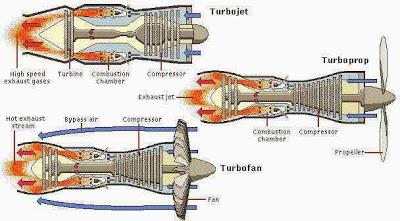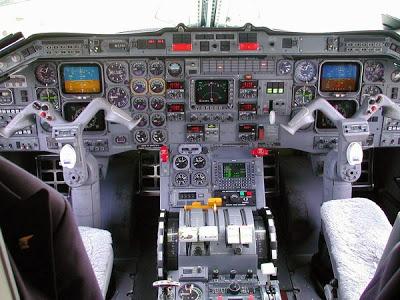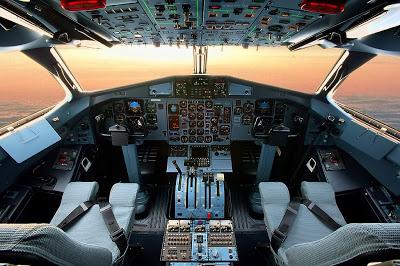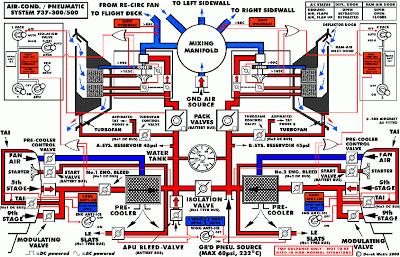Below is an interesting video explaining how the CFM56 produces thrust.
This may come as a great surprise, but there was time when the terms regional airline and turboprop went together like bacon and eggs. Turboprops were what the regionals flew. The planes may have been smaller, they might have been a little loud, and they could easily vibrate a can of coke across a flimsy tray table, but they were money makers, using far less fuel to carry the same number of passengers as regional jets do today. Passengers hated them, but they were very good at their mission and for pilots on their way up the ladder, they were a "stepping stone" to the majors. What is a turboprop? A turboprop is just a jet engine connected to a propeller. During an engine failure on a jet, there is isn't much to see from the cabin...but a failed engine on a turboprop? Idle props are hard to hide.

Where's all that oil going?
I spent six years at a large regional airline, four years flying an EMB-120 Brasilia and two years flying an ATR-72-210...both turboprops. I never had a full-blown engine failure during that time, but I did experienced three fairly serious engine malfunctions that resulted in precautionary shutdowns.
The first occurred on a Brasilia during a low power descent. With both engines near idle, one of the engines began to slowly lose oil. At the time, we had no idea where it was going, but over about a three minute period, the oil level went from normal to almost empty. As it became clear that oil would completely drain from the engine, we elected to shut the engine down in an effort to avoid any serious damage.
Since the engines were already at low power, the loss of thrust made almost no difference in how we flew the airplane. That is, until we powered up the other engine on the approach. ATC gave us a direct heading toward the runway and we didn't have to power up the engine until the last two or three minutes of flight. If the propeller hadn't been static out there on the wing, I don't think anyone on board would have known the difference.

EMB-120 Brasilia cockpit.
I had a similar even on an ATR-72 that was a little more exciting, mainly because we were climbing at the time. On a short, late night flight from Dallas to Houston, we were climbing through about 5,000 feet when a warning light illuminated in the cockpit. The captain, who was flying the airplane at the time, leveled off as I declared an emergency and retrieved the checklist. Oil quantity was steadily decreasing and oil temperature was on the rise. Again, we wanted to shut the engine down before any serious damage was done and probably would have skipped the checklist and done just that if I thought the engine was going to run completely out of oil before I could get to the official procedure.
ATR 72 cockpit.
As it turned out, we had enough time to follow the checklist, but what really stuck in my mind about this particular emergency was what happened after got back on the ground. We were the airline's last flight out that night, and company policy required the ground staff at the airport to remain on duty until we were at least half way to our destination...maybe farther, I can't remember exactly.There wasn't much traffic at the airport that night, and as we turned off the runway the tower controller cleared us directly onto the company ramp without having to contact ground. But as we taxied in, I couldn't get anyone at the company to answer the radio and there wasn't anyone on the ramp to meet the flight. Keep in mind that this was 1997...we didn't have cell phones yet. Today, I could contact the company via cell phone, ACARS, ARINC or the internet phone mounted on the cockpit wall, but this little regional airline didn't have any of those options in 1997.
We convinced some helpful soul at the DFW tower to attempt contact with our company operations, but that wasn't successful either. Apparently, the entire staff had gone home for the night and we were on our own. Where would we park? What would we do with the passengers? Could we even get into the terminal?
Again with the assistance of the DFW tower, we were able to get in contact with another airline who agreed to let us park at one of their gates and even handled the passengers. I was amazed to learn later that they even gave out hotel vouches to our stranded passengers. Normally, an airline will provide vouchers for mechanical delays that result in an overnight stay, but this airline certainly owed us nothing. I'm sure they were reimbursed, but their performance that night was well above what could have been expected.
Are we on fire?
The third event occurred while climbing out of a small town in Mississippi in an EMB-120 Brasilia on our way to Atlanta, Georgia. I was the captain on this flight and as we passed through about 10,000 feet, the Brasilia's warning system chimed in and alerted us to an overheat situation in one of the bleed air ducts. Unfortunately, the system wasn't designed to tell us which one.
Take a look at the schematic below. Sadly, my old Brasilia manuals turned up missing after a recent move, so the picture is from a Boeing 737 manual that I found online...but the concept is the same. Also, the picture is small and difficult to read, but that isn't the point either. Most jet engine pneumatic systems work very much the same way. Extremely hot air is taken from the compressor section of the engine (air gets very hot when compressed) and is then sent through a complicated system of ducts, valves, turbines and cooling devices designed to take air that is hot enough to light a fire and turn it into a cool and comfortable environment for the cabin. The ducts between the engine and the initial cooling devices are especially important, because leaks in this area have the ability to concentrate small blasts of air that have the same affect as a blow torch on surrounding material.

Duct leaks are a serious fire hazard that are always treated as an emergency; and on many airplanes, they involve immediate action items performed by the flight crew from memory. On the Brasilia, the procedure was accomplished from the emergency checklist and one of the first items on that checklist was to start a clock at the first indication of a leak. Next, the pilots would proceed through a complicated process of elimination by individually isolating specific areas of the system, isolating one section at a time to see if the warning light went out in a prescribed amount of time. If unable to determine which section had the leak before the clock ran out, then the leak would have to be stopped at the source...the engine.
I had already leveled the airplane off at 11,000 feet and notified ATC that we had a problem. I can't really blame them, but Air Traffic Control always has a lot of questions that I don't have time to answer during an event such as this...I asked ATC to "standby." I handed control of the airplane to my first officer who was doing an outstanding job assisting me through a difficult situation. As a side note, he was an Embry-Riddle grad with just over 500 hours experience. Regardless of the claims made by proponents of the new 1500 hour rule, he was a capable aviator and an asset to me that day. I was completely comfortable handing him the airplane as I focused on the problem.
I've always hated complicated, long winded emergency procedures like this one. There was a lot to the procedure and I could easily waste valuable time with a simple mistake. However, we were at a safe altitude, the airplane was under control and I was assisted by a capable first officer. The worst case scenario was that I would have to shut the engine down and return to the airport...and we could handle that.
I isolated the first area then waited the prescribed amount of time, but the light refused to go out. I really wish I had that old Brasilia manual so I could refresh my memory about the exact sequence of events, but suffice to say, after running the entire checklist, time ran out and the warning light was still glaring in my face.
Shutting an engine down in flight creates an awful lot of work for the non flying pilot. Honestly, the guy flying the airplane has a much easier job. Airlines spends an inordinate amount of time training pilots to fly the airplane on one engine, and once you get everything trimmed up, it isn't really all that different than flying with two. At any rate, call it selfish or call it smart with a relatively inexperienced first officer, but I wanted the landing and took it. That forth stripe comes in handy every now and then.
Many pilots will go their entire aviation career without losing an engine, but pilots love to tell stories about airplanes and being able to tell one about losing an engine is somewhat of a badge of honor. I remember talking to my dad later that day. He successfully completed a 32 year airline career preceded by 6 years in the Army flying OV-1 Mohawks over Vietnam and never experienced an engine failure...I've had four. (You'll read about the fourth next week) Dad's reaction might surprise you, but I could tell he was little jealous.
